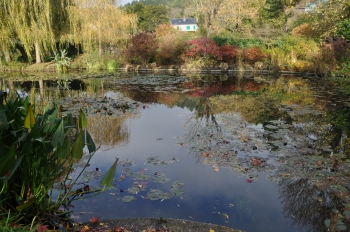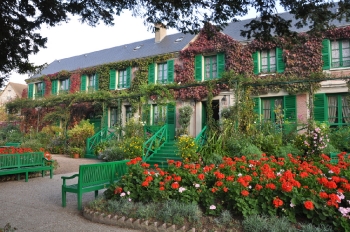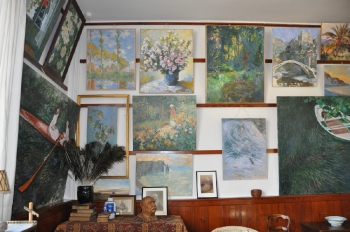November 24, 2014

Fall atmosphere in Monet’s gardens at Giverny.
The picture was taken from the steps of the dock next to the water lily pond.
On the left, the green leaves of pontederias.
The red shrub on the opposite bank is a Japanese maple.
In the distance appears the pink house with green shutters, Monet’s home for 43 years.
On the right, through the branches, the third studio where Monet painted his biggest water lilies panels.
Posted in Claude Monet, Giverny, Water-Garden No Comments »
September 6, 2013
[singlepic id=243 w=320 h=240 float=left]
According to Claude Monet’s step son Jean-Pierre Hoschedé, the painter loved blue flowers.
This beautiful solanum, a plant belonging to the family of tomatoes and potatoes, is covered with simple little blue flowers.
It matches the colors of the kitchen window with its blue squared curtains, a very typical french pattern called vichy fabric.
In late Summer, plants are at the top of their heigth. With a bit of imagination, the flowers of the Giverny garden look like big waves splashing against the walls of the house.
Posted in Monet's flower garden, Monet's House No Comments »
August 29, 2013
[singlepic id=241 w=350 h=350 float=left]
The large window of Monet’s first studio at Giverny looks like an eye scrutinizing the flowers of the garden in order to paint them.
It opens onto the little rose garden, a corner that is rarely explored by the visitors of Giverny.
See two posts below the view from the inside, giving the illusion of a painting.
Posted in Giverny, Monet's House No Comments »
December 17, 2012
[singlepic id=233 w=320 h=240 float=left]Here is another view of Claude Monet’s yellow dining room at Giverny. Bright, charming, cozy, it is often considered inspiring by people seeking new ideas for their home.
The red and creamy tiles on the floor are typical for the local 19th Century style and can be found in many houses around. The furniture, including buffets and chairs, was also widely spread. Monet’s novelty was to paint it in these two tones of yellow.
Nevertheless, a strange spell lies on this dining room. Many visitors remember it as the “yellow kitchen”. However, the neighboring kitchen is absolutely blue, as you can spot through the door.
Posted in Monet's House 15 Comments »
May 28, 2012
[singlepic id=220 w=320 h=240 float=right]The painter Claude Monet had a special eye for refined and simple countryside elegance.
Here, the main entrance to his home at Giverny, an harmony of tender pink and bright green, enhanced by two blue Chinese pots.
The balance is obtained by the symetry of the decoration.
The curtains behind the iron cast door make it look like a puppet theatre.
Posted in Monet's House 2 Comments »
December 2, 2011
 Flashing reds and greens in the soft light of October, this is what Monet’s garden offers in October in the area in front of the painter’s house.
Flashing reds and greens in the soft light of October, this is what Monet’s garden offers in October in the area in front of the painter’s house.
The “Monet green” spreads on benches, shutters, stairs… creating a strong contrast with the formal geranium beds and the virginia creeper on the façade.
Posted in Monet's House No Comments »
April 3, 2011
 Sixty replicas, that is to say very good copies, have just been hung on the walls of Monet’s first studio at Giverny, making the place even more atmospheric.
Sixty replicas, that is to say very good copies, have just been hung on the walls of Monet’s first studio at Giverny, making the place even more atmospheric.
Untill last year, visitors could see prints on canvas on the walls. The new copies are now real paintings on canvas. They were made by a French gallery, galerie Trubetskoy in Paris. The chosen pictures were all in Monet’s own collection of his own work in his late years. These were the paintings he loved most and didn’t want to sell.
In addition, all the details of the studio have been checked on old photographs to be as accurate as possible. The result is stunning and really moving.
Posted in Monet's House 4 Comments »
October 23, 2010
[singlepic=160,350,350,,left]Giverny lies west of Paris, 80 km away from the city, in the Seine valley.
The river flows at the bottom of the hill on the background of the picture. It has carved deeply the tender chalk of the plateau, creating steep hills.
The bottom of the valley is floodable, this is why the village was built at the foot of the hill. It stretches over three kilometers along a single street, now named after Claude Monet.
Only a small portion of Giverny can be seen on the photo. (click to enlarge)
Right in the middle, you can see the big studio of Monet, recognizable thanks to the window panes on the roof. On its right, the long pink house with a slated roof is Monet’s home. And on the right of the house, the next building was Monet’s second studio (see the windows on the roof there too).
Behind these three buildings one can notice the garden. The trees on the pond side blend into the nature around, hardly noticeable by their more vibrant colors. And behind Monet’s gardens, fields show that there are good alluvial grounds here.
Nesting in its natural surroundings, Giverny is a rural village in the countryside, living on a slower pace than the big city of Paris. Being a nice day out is one of the assets of an excursion to the home of Claude Monet.
Posted in Giverny, Monet's House No Comments »
February 6, 2010
[singlepic=143,350,350,,left]During the Winter, when Giverny is closed for five months, the shutters of Monet’s house remain shut.
It must be dark inside, but nobody cares. The shutters prevent the cold wind from entering the building, maintaining a thin layer of warmer air behind the windows.
I don’t know if the japanese prints are still kept hanging on the walls. If they are, darkness is a relief for their fragile colors.
Shut shutters look like closed lids. When it is cold outside, sleeping is the best thing to do, isn’t it?
So do the bulbs hidden in the flower beds and the buds on the branches. Yes, sleeping is the best option before a very long time of intense activity.
Posted in Monet's House 7 Comments »


